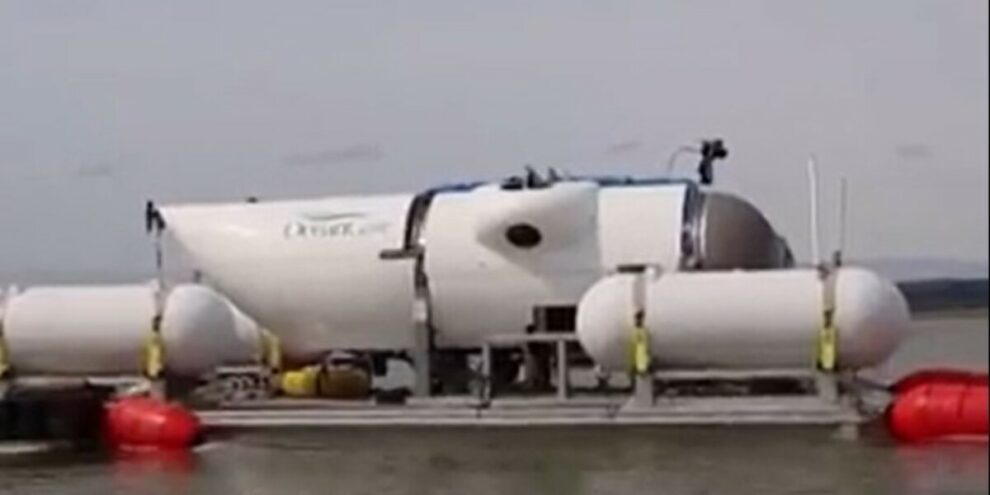A “debris field” has been discovered by an underwater robot searching near the wreck of the Titanic for a missing submersible, rescuers said Thursday, raising fears the five on board are no longer alive.
The development came after organizers of the multinational response insisted the mission to locate the craft was still focused on saving the crew and passengers — despite concerns that, even if the vessel is still intact, its oxygen may have run out.
The US Coast Guard has not confirmed whether the debris belonged to the small tourist sub, lost somewhere in a vast swathe of the North Atlantic between the ocean’s surface and more than two miles (nearly four kilometers) below.
“Experts within the unified command are evaluating the information,” the Coast Guard said in a tweet, adding that it would hold a press briefing at 3:00 pm (1900 GMT) in Boston.
But marine scientist and oceanographer David Mearns, who specializes in deep water search and recovery operations, said the development indicated a “catastrophic failure,” probably “an implosion.”
“They don’t use phrases like ‘debris field’ unless there’s no chance of a recovery of the men alive. A debris field implies a breakup of the submersible,” he told Sky News.
“The only saving grace about that is that it would have been immediate, literally in milliseconds, and the men would have had no idea what was happening,” added Mearns, who was friends with two of those onboard.
Based on the sub’s capacity to hold up to 96 hours of emergency air, rescuers had estimated that the passengers, which include fee-paying tourists, may have run out of oxygen in the early hours of Thursday.
But as that possible deadline passed, US Coast Guard Rear Admiral John Mauger said rescuers were “fully committed” to search operations.
A surge of assets and experts have joined the operation in the past day, including two more Remotely Operated Vehicles (ROVs) on Thursday, and sonar has picked up unidentified underwater noises.
Organizers of the response — which includes US and Canadian military planes, coast guard ships and teleguided robots — are focusing their efforts close to the sounds.
The noises, heard Tuesday and Wednesday raised hopes that the passengers were still alive, though experts have not been able to confirm their source.
– ‘Main hope’ –
The French research ship Atalante deployed an unmanned robot able to search at depths of up to 6,000 meters (nearly 20,000 feet) below water on Thursday, the US Coast Guard tweeted.
Experts have called the Victor 6000 “the main hope” for an underwater rescue.
The Canadian vessel Horizon Arctic also deployed a robot that had already reached the ocean floor and begun its search.
Mauger has also said that vessels carrying medical staff and a decompression chamber are en route to the area.
The 21-foot (6.5-meter) Titan began its descent at 8:00 am on Sunday and had been due to resurface seven hours later.
But the craft lost communication with its mothership less than two hours into its trip to see the Titanic.
It was carrying British billionaire Hamish Harding and dual Pakistani-British citizens Shahzada Dawood, a tycoon, and his son Suleman. OceanGate Expeditions charges $250,000 for a seat on the sub.
Also on board is OceanGate’s CEO, Stockton Rush, and a French submarine operator Paul-Henri Nargeolet, nicknamed “Mr Titanic” for his frequent dives at the site.
Ships and planes have scoured 10,000 square miles (around 20,000 square kilometers) of surface water — roughly the size of the US state of Massachusetts — for the vessel.
The Titanic’s watery grave is situated 400 miles off the coast of Newfoundland, Canada, and more than two miles below the surface of the North Atlantic.
Experts say that even if the submersible is found, raising it from deep water would be challenging.
The Navy has sent a specialized winch system for lifting heavy objects from extreme depths along with other equipment and personnel, while the Pentagon has deployed three C-130 aircraft and three C-17s.
The Titanic hit an iceberg and sank in 1912 during its maiden voyage from England to New York with 2,224 passengers and crew on board. More than 1,500 people died.
It was found in 1985 and remains a lure for nautical experts and underwater tourists.
The pressure at that depth as measured in atmospheres is 400 times what it is at sea level.
In 2018, OceanGate Expeditions‘ former director of marine operations David Lochridge alleged in a lawsuit that he had been fired after raising concerns about the company’s “experimental and untested design” of Titan.
